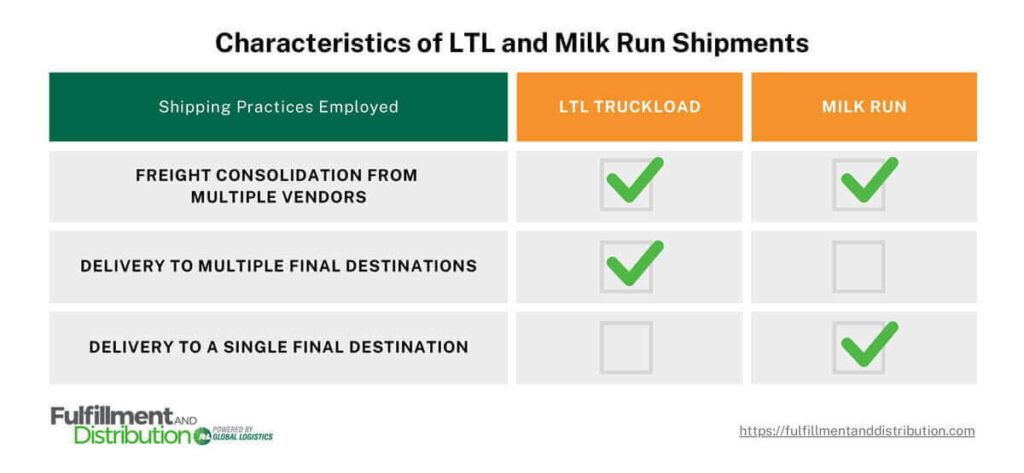
 Copy URL to Clipboard
Copy URL to Clipboard
Despite its origins in old milk delivery practices, these days a milk run in logistics can be used to transport all types of goods. This consolidated delivery strategy can help your business maintain efficient inventory levels and production times.
Key Takeaways
In modern logistics, a milk run is a delivery solution that moves goods from various suppliers to a single end-stage destination, such as a warehouse or distribution center, all in one trip. This method depends on using a fixed route with a single supply vehicle carrying multiple mixed loads.
You may wonder why this practice is called a milk run in the first place. Before we get into further detail about whether milk run logistics could help your business, let’s take a moment to examine the term’s historical context.
In the early 20th century, horse-drawn carriages were commonly used for local deliveries. Part of the milkman’s responsibilities was to gather milk from different dairy farmers and deliver that milk to a distribution center (DC) for bottling.
Later, he would deliver fresh milk to each residence, replacing empty bottles with full ones. This process saved costs on using multiple carriages and provided the distributor with an idea of consumer demand. Eventually, the carriages gave way to milk trucks and tankers, but the same basic principle remained.
While consumer demand is usually projected via specialized software these days, the idea of consolidating shipments from several farmers into one load headed for the same facility gave us the modern practice of milk run logistics: a single route between multiple suppliers sending shipments to the same customer.
Let’s say you run a small wheel and tire shop. Items in your inventory include:
In order to maintain a diverse stock of goods, you purchase them from several different manufacturers. You could have each of these suppliers send you their goods on separate trucks, which is a very basic logistics practice.
However, having a single vehicle pick up stocking orders from each manufacturer in order to deliver all of them to your shop at once may be preferable from an efficiency standpoint. Doing so would be an example of a milk run delivery.
We can take this one step further by closing the delivery loop entirely, which would look like this:
For businesses moving goods through the supply chain on a set schedule, this method contributes to a lean logistics model. Such a model balances meeting consumer demand with preventing capital from being unnecessarily tied up in extra inventory.
On a smaller scale, milk runs can also be used within manufacturing and assembly facilities. A warehouse worker may use a warehouse utility vehicle to gather components from multiple storage areas for delivery to an assembly line.
In either scenario, timing and proper scheduling are key to a successful milk run.
Related: Types of Warehouse Management Systems
If you have some experience with different types of delivery strategies, you might look at the elements of a milk run and find them almost indistinguishable from those of a less-than-truckload (LTL) delivery.
I’ve put together the following chart to highlight the similarities and differences between these two strategies.

As mentioned earlier, a carrier might return pallets and/or containers from previous shipments to vendors en route. However, any actual goods carried are intended for a single destination.
Related: How Pallet In Pallet Out Can Improve Your Inventory Flow
Like almost any distribution strategy, milk runs have their strengths and weaknesses. Businesses seeking to refine their logistics process should consider the following pros and cons when deciding if implementing milk runs would be beneficial.
Pros:
Cons:
Ultimately, the milk run strategy is most ably implemented by logistics professionals with the experience to overcome challenges and meet your business needs. Given the tight timing and scheduling requirements this strategy demands, it’s wise to work with a trusted and proven carrier with a track record of successful time-sensitive deliveries.
Related: 10 Reasons You Need to Outsource Inventory Management to a 3PL
From milk runs to complete third-party logistic (3PL) partnerships, Fulfillment and Distribution has the network and know-how to handle all of your warehousing and delivery needs.
Our full list of services also includes:
Give us a call at (866) 989-3082 or request a quote online today. No matter what products you need to store and ship, we’re standing by to help your business succeed.
